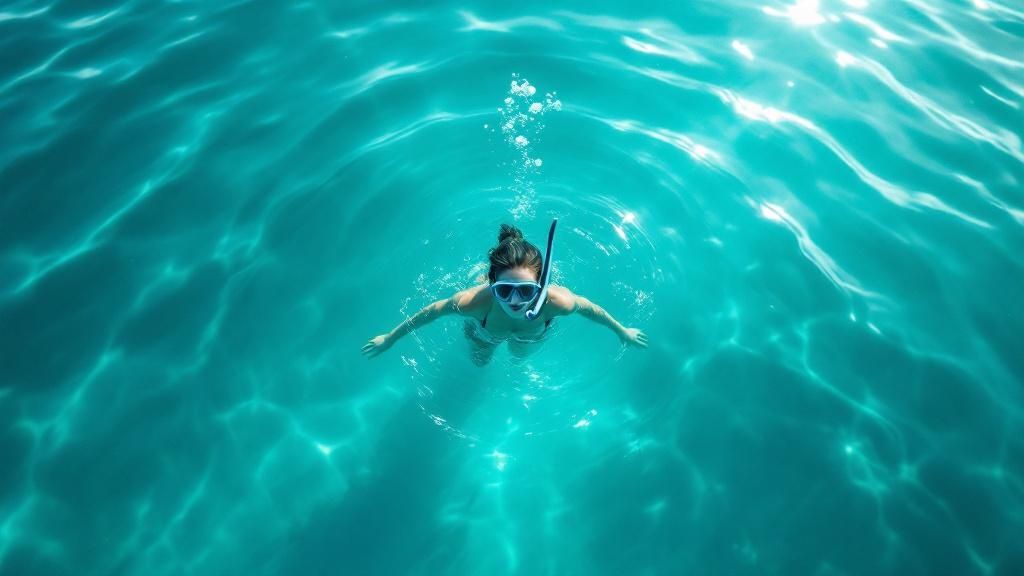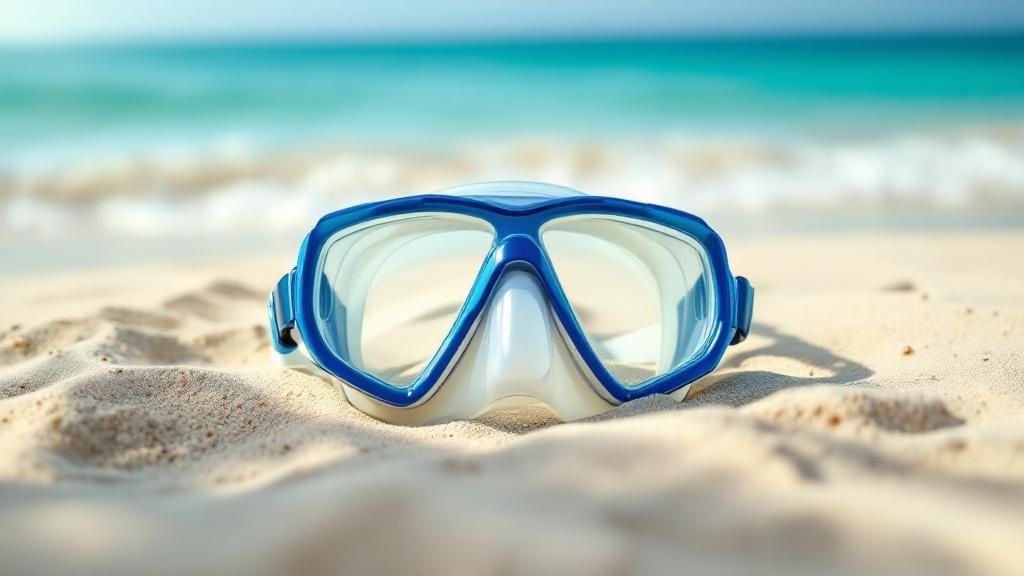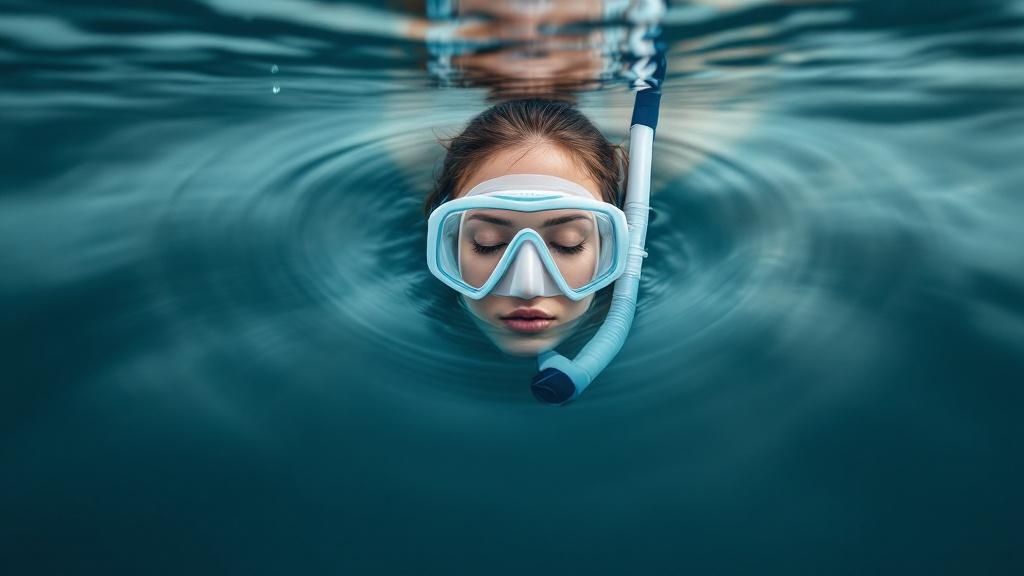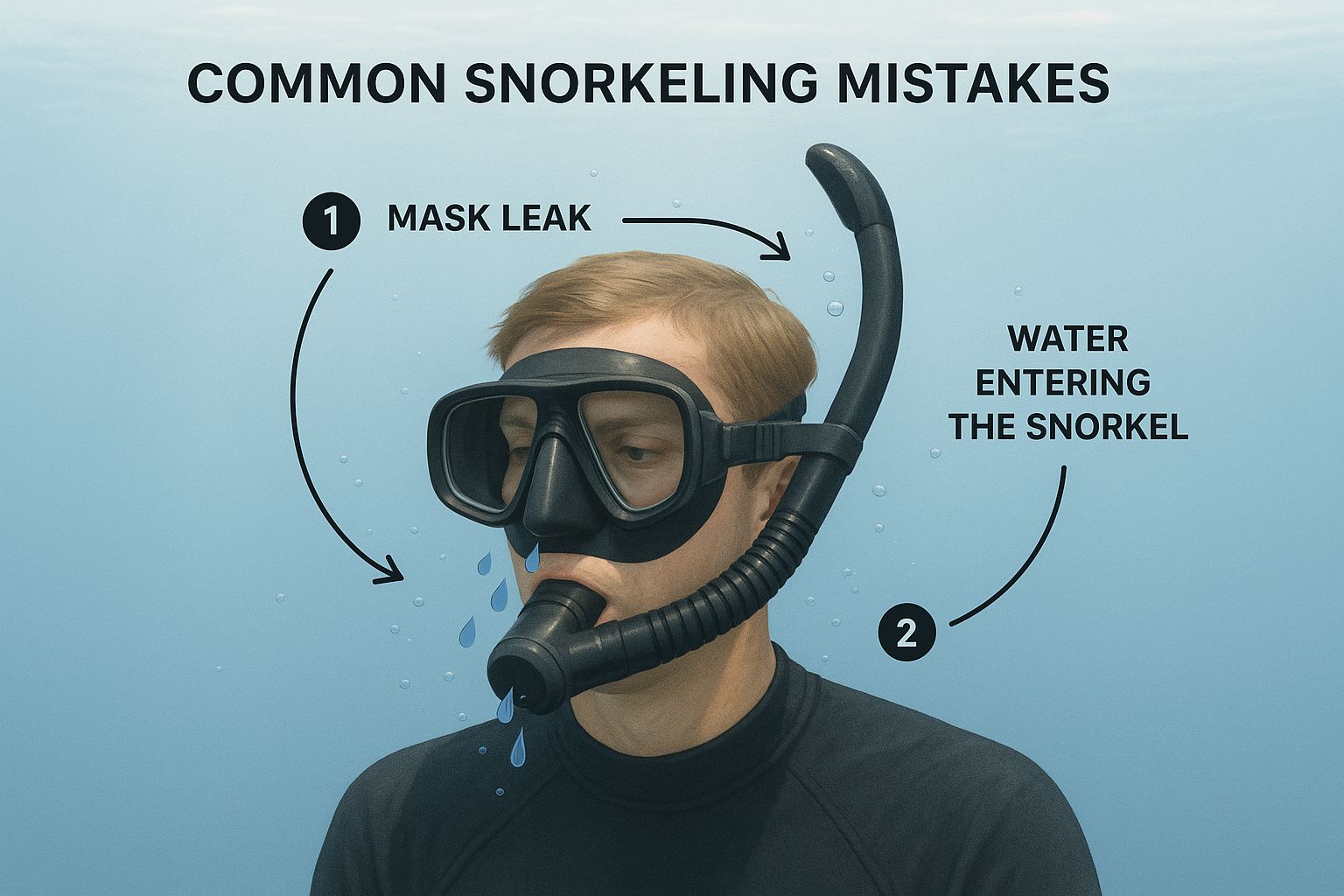How to Breathe When Snorkeling A Guide for Beginners

Alright, let's get this done. The most common mistake I see beginners make isn't with their fins or mask—it's how they breathe. It sounds simple, but it’s the one thing that can turn an amazing day into a panicky, frustrating experience.
The absolute key to how to breathe when snorkeling is to take slow, deep, and deliberate breaths through your mouth. Think of it like calm, meditative breathing, but with a tube.
This isn’t just about getting enough air. It's about staying relaxed, saving your precious energy, and making sure you’re actually getting fresh oxygen, not just recycling the old stuff. If you start taking short, panicked breaths, you're going to feel overwhelmed, and fast.
Mastering the Most Important Snorkeling Skill
So, you're ready to explore the underwater world. Before you even think about jumping in, we need to talk about the one skill that truly makes or breaks the entire adventure: breathing. Forget the obvious advice; let's break down the why behind this specific technique so you can have a safe, unforgettable time out there.
Why Slow and Deep Breathing Is So Critical
I know, it feels a little weird at first. But breathing slowly and deeply through your snorkel is a non-negotiable for a good reason. Your snorkel tube creates something we call dead air space—it’s a pocket of your last exhale that gets trapped inside the tube.
If you start taking quick, shallow breaths, you never fully push that old air out. Instead, you just end up re-breathing it. This leads to a buildup of carbon dioxide, which is what triggers that sudden, panicky feeling of breathlessness.
Think of it this way: Your lungs and the snorkel are one connected system. A long, deep inhale pulls fresh air all the way down past that stale pocket. A powerful, full exhale is what it takes to forcefully push all the used air completely out of the tube.
This isn't just a feeling; it's physics. This specific breathing method directly impacts the gas exchange happening in your lungs. Taking those long, rhythmic breaths can actually double the amount of fresh air reaching your lungs compared to frantic, shallow breathing. This keeps your body properly oxygenated, your heart rate down, and your energy levels up for way longer in the water. You can read more about proper breathing techniques if you want to geek out on the science behind it.
To see the difference in action, let's compare the two styles side-by-side.
Breathing Technique Breakdown: Slow vs. Fast
The way you breathe directly affects your comfort and safety. Here’s a quick look at what’s really happening with each breath.
| Breathing Style | Oxygen Exchange | Energy Use | Safety Risk |
|---|---|---|---|
| Slow & Deep | Excellent. Fully clears stale air and maximizes fresh oxygen. | Low. Conserves energy for longer, more relaxed snorkeling. | Low. Promotes calm and reduces the risk of CO2 buildup. |
| Fast & Shallow | Poor. Leads to re-breathing stale air from the snorkel tube. | High. Wastes energy and leads to quick exhaustion. | High. Can cause anxiety, dizziness, and a feeling of breathlessness. |
As you can see, taking the time to master slow, deep breathing pays off immediately.
It’s the skill that gives you the confidence and control to stop focusing on the act of breathing and start paying attention to the incredible marine life all around you. Once you have this down, you’ll feel ready to explore a variety of water sports activities with the same cool-headed assurance.
Setting Up Your Gear for Effortless Breathing

Think of your mask and snorkel as your lifeline to the underwater world. I've seen it time and time again: a poorly fitted mask can turn an amazing day into a frustrating one. Getting your gear set up right from the start is the secret to calm, effortless breathing out there.
Finding the Perfect Mask Seal
The most common culprit for a bad time is a leaky mask. That constant trickle of saltwater is more than just annoying; it makes you want to gasp, completely throwing off your rhythm. Luckily, you can check the fit before you even get your feet wet.
Just hold the mask gently to your face, but don't use the strap yet. Now, inhale a little bit through your nose. Does it stick? If it creates a light suction and stays put all on its own, you’ve got a winner. If it falls right off, that mask just isn't the right shape for your face.
Once you find a mask with a good seal, place the strap around the crown of your head, not down by your neck. A lot of beginners make the mistake of overtightening the strap, thinking it'll stop leaks. It actually does the opposite, warping the soft silicone skirt and creating new leaks. It just needs to be snug enough to hold it in place.
A good fit is all about the seal, not how tight you can crank the strap. Once you’re in the water, the gentle pressure will do most of the work to keep the mask perfectly sealed to your face.
Positioning Your Snorkel Correctly
Your snorkel is your air supply, so let's get it right. When your face is in the water, you want the tube pointing straight up to the sky. This simple vertical position makes it much harder for waves to splash down inside. Most snorkels have a clip that attaches right to the left side of your mask strap, keeping it secure and perfectly positioned.
Also, try to relax your jaw. You don't need a death grip on that mouthpiece. Just bite down gently on the little tabs and let your lips form a natural seal around the outside. This small change makes a huge difference in preventing jaw fatigue, which is a surprisingly common complaint after a long snorkel.
Finally, a little care between trips goes a long way. Taking the time to learn how to clean your snorkel gear properly ensures there's no salt or sand buildup messing with the seals or valves. It's a simple step that guarantees your gear will be reliable for your next adventure.
Taking Your First Confident Breaths in the Water

Let's be honest, that first moment of putting your face in the water and trying to breathe through a tube feels… weird. It goes against every instinct you have. The secret to getting past this is simply building up your confidence in a place where you feel completely in control. Forget about deep water for now; we're starting where you can stand up.
Find yourself a nice, calm spot with water that’s shallow enough for you to easily stand with your head well above the surface. Taking away any worry about the depth lets you put all your focus right where it needs to be: on your breathing.
Mastering the Feel in Shallow Water
Alright, with your mask and snorkel on, just stand there in the water. Bend your knees, and gently lower your face into the water—just enough to submerge the mask. Keep your feet planted firmly on the bottom. Now, take that first breath through the snorkel.
Make it slow and deliberate. Pay attention to the sound of your own breath moving through the tube. Feel your chest rise and fall. Just take a few of these relaxed breaths, getting used to the whole sensation without any pressure to swim. From my experience, this single exercise is the absolute game-changer for new snorkelers.
The goal isn't just to breathe; it's to teach your brain that this new way of breathing is safe and reliable. Once you trust the snorkel, the anxiety disappears.
Once that feels second nature, you can start making the move from standing to floating.
From Standing to Floating
Still in your shallow, safe spot, gently lift your feet off the bottom and let yourself float on your stomach. Your body position will change, but your breathing shouldn't. Keep that same calm, rhythmic pattern you just practiced.
- Keep your rhythm: Stick with those slow, deep breaths. Don't rush it.
- Point your snorkel to the sky: As you float, make sure the tip of your snorkel is aimed straight up. This is the best way to keep water from splashing in.
- Let the water hold you: Relax every muscle. A tense body burns through oxygen and energy way faster.
By mastering your breathing in this simple, step-by-step way, you're building a solid foundation of confidence that will stick with you. You're creating a muscle memory of calmness that you can tap into when you finally swim out over those incredible reefs.
Solving Common Snorkeling Breathing Problems
Even with the best gear and the calmest water, little things can still happen. It’s part of the experience. A rogue wave might send a splash of water down your snorkel, or you might get a little winded after an exciting chase to see a parrotfish up close.
The key is to know what to do and, most importantly, not to panic. Here’s my breakdown of how to handle the most common breathing hiccups right when they happen, so you can get back to enjoying the view.

As you can see, these little issues are totally normal. Knowing how to react calmly makes all the difference between a minor interruption and a ruined afternoon.
Clearing Water From Your Snorkel
So, you’ve just inhaled a surprise mouthful of saltwater. It happens to everyone! It’s startling for a second, but the fix is incredibly simple. The go-to technique is what we call the blast clear.
It’s exactly as aggressive as it sounds. You just need to give one single, sharp, forceful exhale into the snorkel. I tell people to imagine they're trying to shout the word "TWO!" as hard as they can. That powerful burst of air forces the water up and out of the top of the tube. Problem solved.
Many modern snorkels make this even easier with a built-in purge valve at the bottom. If your snorkel has one of these, you often only need a gentle puff of air. This is enough to push the water out through the one-way valve near your chin, which is much less effort.
Handling Feelings of Breathlessness
If you suddenly feel out of breath or a wave of anxiety hits, trying to push through it in the water is the worst thing you can do. It just makes the feeling worse. Your first move should always be to stop, reset, and get your composure back.
The quickest way to recover is to simply stop kicking, lift your head out of the water, and take a few normal, calm breaths. This lets you reset your breathing without the snorkel and immediately eases that feeling of "air hunger."
Once you feel your heart rate settle and your breathing return to normal, you can put your face back in the water and go back to those slow, deliberate breaths. Snorkeling is supposed to be relaxing, not a race.
It’s also worth knowing that feeling a little bit of resistance is normal. Because you're breathing through a tube, there’s some natural "dead space" that increases respiratory resistance by about 6.5%. While this can slightly decrease your ventilation, studies have found it doesn't significantly increase the overall effort for most people. Your body can handle it; just focus on smooth, deep breaths to manage the sensation. If you're curious, you can discover more insights about snorkeling breathing on SnorkelingMarathon.com.
Take Your Snorkeling to the Next Level
So, you've gotten over that initial hump. You're comfortable with the gear, and the whole breathing-underwater thing doesn't feel so alien anymore. Now the real fun begins. It's time to stop just surviving in the water and start thriving.
The secret to a long, incredible snorkel session isn't about physical fitness; it's about efficiency. It’s all in how you breathe and move. Once you nail this, you’ll be amazed at how much longer you can stay out there, just soaking it all in.
Find Your Breathing Rhythm
Your breath is your engine. A frantic, gasping breath will burn through your energy in minutes. But a calm, steady rhythm? That’s the ticket to an hour-long exploration.
Think of it like meditation. Settle into a consistent pace. A slow, three-second inhale, followed by a smooth, three-second exhale. This simple trick keeps your heart rate down, your muscles relaxed, and your mind focused on the incredible world below you.
Perfect Your Posture in the Water
How you hold your body is just as crucial as how you breathe. You want to be a human log, floating effortlessly on the surface. The goal is to be perfectly horizontal and streamlined.
Every time you lift your head or let your legs sink, you create drag. That drag forces your muscles to work overtime just to stay in place.
- Keep your body flat, from your head to your fins.
- Relax your arms and let them float at your sides, or clasp them gently behind your back.
- This streamlined position lets you glide through the water with almost zero effort.
Pro Tip: Pay attention to your snorkel's angle. You want it pointing straight up at the sky. A vertical snorkel is your best defense against small waves and splashes, meaning you won't have to constantly blast-clear it. This saves a surprising amount of energy and lets you stay locked in on the view.
Master the Recovery Breath
Eventually, you'll spot something amazing and do a quick dive to get a closer look. It’s part of the fun! But when you pop back up to the surface, you’ll have a slight oxygen debt. The instinct is to gasp, but that can leave you feeling panicky and winded.
Instead, practice recovery breathing. It’s a game-changer.
The moment you surface, give one powerful exhale to clear any water from your snorkel. Immediately follow that with three quick, deep breaths. This technique rapidly settles your oxygen debt and gets you back to a calm, relaxed state in seconds.
It’s incredible what the human body is capable of. While we're just enjoying the surface, some extreme breath-hold divers push their bodies to unbelievable limits, reaching depths over 100 meters where their lungs compress to a fraction of their size. We aren't going anywhere near that, of course, but it’s a good reminder of why efficient breathing is so important for both safety and enjoyment. You can actually read more about the wild physiological limits studied in divers on PMC.
When you combine these advanced techniques with perfect conditions, you're set for the snorkel of a lifetime. To learn how to find those perfect days, check out our guide on the best time to snorkel on the Big Island.
Common Questions About Snorkel Breathing
Even with the best preparation, questions always seem to pop up once you're about to hit the water. I get it. Getting clear answers is the best way to build confidence before you even get your fins wet. Let’s go over some of the most common ones I hear from first-timers.
Is It Normal to Feel a Little Out of Breath?
Yes, that's completely normal when you're just starting out. Your snorkel tube creates a little bit of what’s called "dead air space." It just means you end up re-breathing a tiny amount of your last exhale. This can make you feel slightly air-hungry until your body adjusts.
The trick is to really focus on taking slow, deep, and deliberate breaths. Think about fully flushing the tube with fresh air on every inhale. If you ever feel genuinely winded, just stop. The safest thing to do is float on your back, take the snorkel out, and catch your breath normally for a moment to reset.
Can You Breathe Through Your Nose?
With a traditional snorkel and mask, that's a definite no. Your mask has to create a perfect, watertight seal around your eyes and nose, and trying to inhale through your nose will just suck the mask uncomfortably tight against your face.
You have to commit to breathing only through your mouth with the snorkel. I know it feels weird for the first few minutes, but trust me, it becomes second nature very quickly.
Full-face masks are an alternative that allows for nose breathing, but they come with their own set of pros and cons.
What Should I Do If Water Gets in My Snorkel?
Don't panic—it happens to even the most seasoned snorkelers. A wave comes over, you look down too far, it's just part of the experience.
The easiest fix is the "blast clear" method. All you do is give one single, sharp, forceful exhale. I tell people to try shouting the word "TWO!" through the tube. That powerful burst of air will shoot the water right out the top.
Many modern snorkels also have a one-way purge valve at the bottom. With these, a gentle puff is often all it takes to push the water out through the valve near your chin, which makes clearing even easier. If you have more questions about what to expect on a tour, check out these answers to frequently asked questions about Kona snorkel tours.
